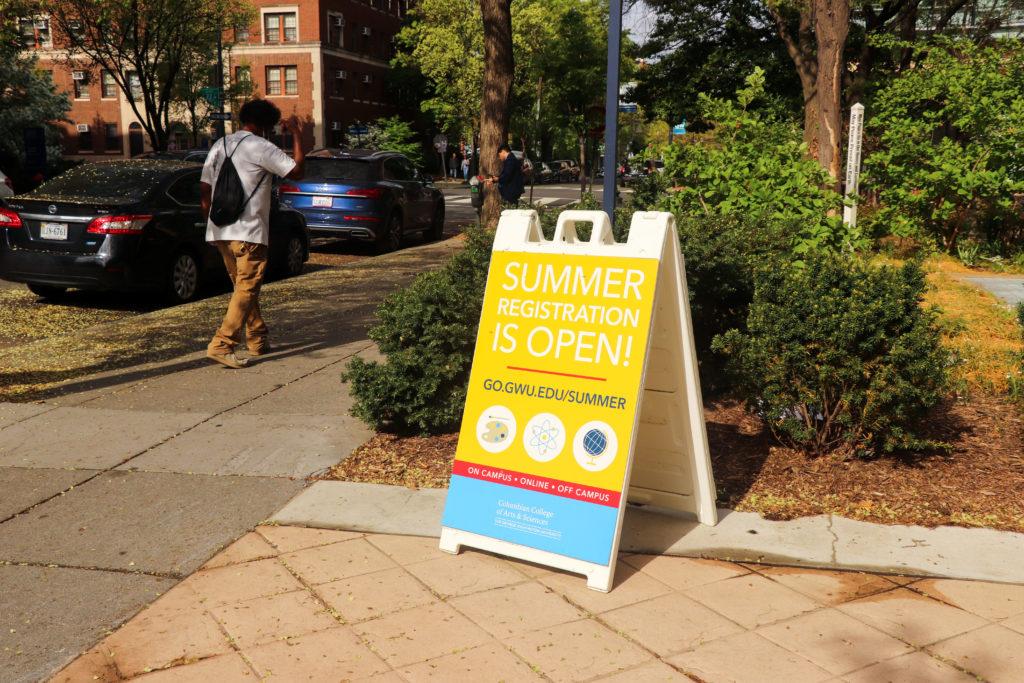GW’s undergraduate summer course tuition is the third most expensive among its 12 peer schools.
Undergraduate students who enroll in online and in-person summer courses pay $2,080 per credit hour this summer – at least $400 per credit hour more than the average summer tuition at 10 of its 12 peer universities. GW’s summer tuition per credit hour this year is a slight uptick from last summer’s price of $1,995 per credit hour and comes after the University raised tuition for the upcoming academic year from $62,110 to $64,700.
Boston University charges students $775 per credit hour for summer courses – the cheapest summer tuition rate out of all 12 peer schools – while Georgetown University trails GW with a tuition rate of $1,910 per credit hour. The two peer schools that charge more for summer courses than GW are the University of Miami, which charges $2,310 per credit hour and the University of Southern California, which charges $2,137 per credit hour.
[gwh_image id=”1188043″ credit=”Nicholas Anastacio | Graphics Editor” size=”large” align=”none” /]
Experts in higher education finance said higher summer course tuition rates can help a university avert revenue loss caused by students opting to take summer courses instead of classes during the academic year.
Richard Vedder, a distinguished professor of economics emeritus at Ohio University, said some universities like Ohio University charge the same amount for summer terms as they do for the fall and spring semesters because the quality of education remains the same. He said cutting summer tuition prices might increase summer enrollment and deter enrollment during the academic year, a figure officials want to remain high to continue collecting steady revenue in the fall and spring.
“We don’t give bargain basement rates for summer, and because if we did so, students would start taking lots of summer school courses,” Vedder said. “Some of them would try to even graduate, maybe in three years or whatnot, and it would in effect, cut out tuition that would normally be paid during the academic year.”
GW’s current $62,110 tuition for the 2022-23 academic year covers 18 credit hours per semester at a rate of $1,725.28 per credit hour – $354.72 lower than the University’s summer course tuition rate. University spokesperson Julia Metjian declined to comment on which factors contribute to the summer course tuition rate and how many students have enrolled in summer courses each year, deferring to a release about 2023-24 academic year tuition rates.
Vedder said other universities decrease the cost of tuition per credit in the summer to attract students to enroll so they can charge residents for room and board in campus buildings that would otherwise be vacant during the summer. He said universities can make additional revenue from summer course tuition that they might not be able to make during the academic year.
“Some [universities] want to make extra money and would jump at the opportunity of teaching summer school to make extra money, so why don’t we try to have our classrooms used more months of the year and collect money in the summer that we would not normally get from those classrooms?” he said.
Tolani Britton, an assistant professor of education at the University of California Berkeley, said class sizes in summer classes tend to be smaller than during the academic year across the country. She said the lower level of enrollment over the summer could push universities to raise the per-credit cost of summer courses if they need more revenue to fund them without an entire student body paying to live and study on campus.
She added that many universities might need to hire adjunct professors for summer terms because many full professors are “nine-month employees” who only work during the fall and spring semesters.
“Many times, the costs have to be standardized in institutions across majors though costs are different for courses that require more equipment or labs, for example,” Britton said in an email.
The Columbian College of Arts & Sciences offers summer scholarships for students who were previously granted need-based financial aid during the academic year, prioritizing students taking summer classes that fulfill G-PAC or major requirements. Last summer, each scholarship awardees received at least $1,995, the cost of one credit hour for the term, according to the CCAS website.
Linda DeAngelo, an associate professor of higher education at the University of Pittsburgh, said summer tuition costs can change depending on if universities want the summer tuition to fully cover the price of offering summer courses.
“It really depends on if summer tuition is meant to be self-supporting,” DeAngelo said. “In other words, is running the summer program supposed to be net zero so all of running the summer program is funded by the tuition?”
DeAngelo said some universities may include the summer session as part of their academic year while others schools, like GW, might consider the summer semester to be separate from the academic year. She said schools that do not consider summer to be a part of the school year might charge lower summer credit hours prices than the fall and spring semesters.
“The tuition revenue from the summer is what’s paid for that summer term to run and that can result in higher costs in terms of tuition,” DeAngelo said. “A school that considers the summer a regular academic term is going to be very different than a school who runs a summer session which is different from their regular academic term.”







